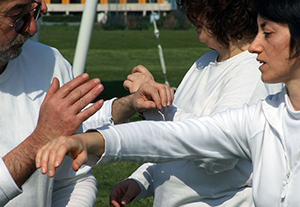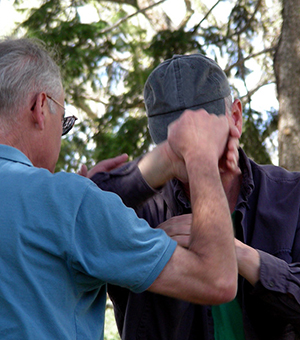 If you train Tàijíquán (太極拳) as a martial art, you will, at some point, come across Tui Shou (推手). Also known as Pushing Hands, (Pushands, Push Hands), this type of training is an incremental step in the direction of Tàijí sparring. This training usually progresses from fixed-step training drills, to fixed-step pushing, to moving step training drills, to moving-step pushing, and then finally to Tàijí sparring drills, two-person fighting set, and Tàijí sparring.
If you train Tàijíquán (太極拳) as a martial art, you will, at some point, come across Tui Shou (推手). Also known as Pushing Hands, (Pushands, Push Hands), this type of training is an incremental step in the direction of Tàijí sparring. This training usually progresses from fixed-step training drills, to fixed-step pushing, to moving step training drills, to moving-step pushing, and then finally to Tàijí sparring drills, two-person fighting set, and Tàijí sparring.
The problem is that many of us who train in Pushing Hands find ourselves focused on the wrong things, leading to bad training habits that can stunt our growth along the path from fixed-step drills to Tàijí sparring. To develop true skill in this training, we must always measure techniques we use now against how well they will help later in training. Some of the most common mistakes I see in both beginners and advances Pushing Hands students are:
-
Using techniques not common to Pushing Hands
Have you ever been Pushing Hands and suddenly your training partner put into a painful joint lock, or actually attempted an eye-jab or throat strike? I have. As a beginner to Pushing Hands, I had no idea what to do to counter these techniques. When I complained to my partner that these were not the point or focus of this training, his response was, “You’re learning self-defense. These are the kinds of things that people will try to use on you on the street.”
The problem with this is that for the rest of that Pushing Hands session, the aggressor stoked his ego, while I flailed around uselessly because he was training fixed-step Tàijí sparring, while I was still trying to do fixed-step Pushing hands. Training in Pushing Hands happens between partners. This means that ultimately you should be working with your friend to bring both your skill levels higher. Tearing your training partner down may make you feel good in the short run, but it makes you a bad partner. Eventually nobody’s going to work with you!
-
Relying on speed, not skill, to get out of a jam
I have lost count of the hundreds of times I’ve seen this happen. I will be training with a partner and we start slowly, pushing and neutralizing until suddenly my training partner finds him or herself in a bad position. They are about to fall, so suddenly they speed up, effectively countering the push that would have toppled them.
This works great when you’re training slowly, but what happens after you speed up and find yourself in the same jam? Once you are going as fast as you can go, you can’t go any faster. Then what? Usually you will fall, and it’s much harder to undo a bad habit when you’ve already graduated to moving swiftly. So my advice is, if you’re about to get pushed over . . . let it happen. It sucks, but you will learn from it.
-
Using a technique that works well for only one type/style of Pushing Hands training
 In intermediate and advanced stationery (fixed-step) Pushing Hands, I will often see students who are pu
In intermediate and advanced stationery (fixed-step) Pushing Hands, I will often see students who are pu
lled off balance throw their bodyweight into their opponent as they fall. The unexpected movement knocks their training partner off balance while simultaneously propping himself or herself up.It’s a great technique to save you from falling, but it only works in fixed-step Pushing Hands. The moment you add stepping into the mix and try that technique, you are likely to find yourself doing a face-plant on the floor. Once again, if you’re about to fall, check your ego, and let yourself fall. Relying on this or other, similar, techniques to get you out of trouble just develops a bad habit you’ll have to contend with when you graduate to moving-step Pushing Hands.
-
Only training with competition in mind
Sometimes when training in class, you might find yourself paired with a partner who is much better than you are. It’s not fun—and often not helpful to your training—when this person pushes you down repeatedly just because they can.
Training in class is different from training for competition (or pushing in actual competition for that matter). Once again, you are partners. Pushing someone down feels like a sense of accomplishment, but it’s no good if they aren’t learning something from it. It’s not always helpful to a training partner if you take advantage of every opening they offer you. It’s sometimes more helpful in training to let your partner to get in close, past your defenses, testing one another’s ability to get out of a precarious situation.
It’s different if you’re training for a competition, at that point, you don’t ever let them in, and you take advantage of any opening they leave you, but your partner should know before you start your practice session that this is what you have in mind. This ensures you both get something out of the training session.
At this point, you can easily see that ego comes into play in every one of these instances. That’s a trap, however, which will lead to bad training habits. Being good in Pushing Hands isn’t the ability to push someone else over whenever you want. It’s the ability to keep yourself from falling! The only way to get there, though, is by getting pushed over. The famous master, Jou Tsung Hwa, was once asked how he got so good at Pushing Hands. His answer was, “I fell a lot.”
Cuatro errores comunes en el empuje de manos | Magia Normal
[…] hora de acometer el trabajo de empuje de manos, inspirado por las cosicas que pasan y ayudado por este artículo, que parafraseo con permiso del autor, quien dice (lo que sigue hasta el final es […]
Cuatro errores comunes en el tuishou | Shuilian Club
[…] hora de acometer el trabajo de empuje de manos, inspirado por las cosicas que pasan y ayudado por este artículo, que parafraseo con permiso del autor, quien dice (lo que sigue hasta el final es […]
Cuatro errores comunes en el tuishou | Escuela Shuilian Dong
[…] hora de acometer el trabajo de empuje de manos, inspirado por las cosicas que pasan y ayudado por este artículo, que parafraseo con permiso del autor, quien dice (lo que sigue hasta el final es […]